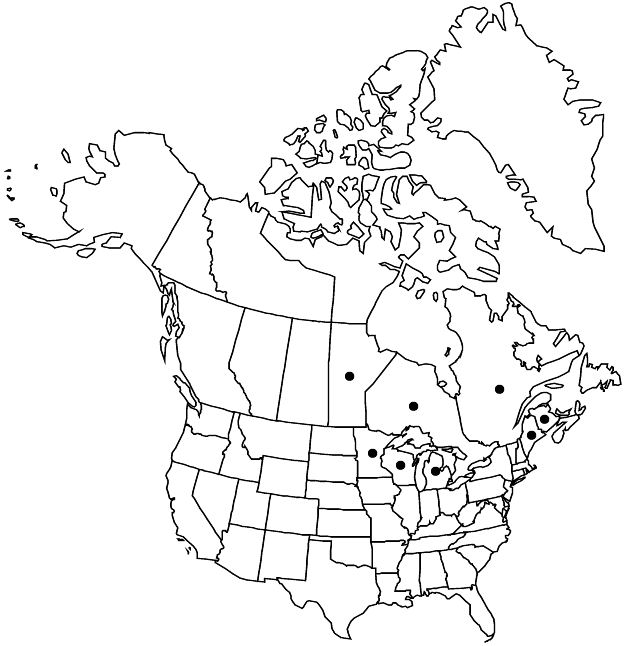Difference between revisions of "Viola novae-angliae"
Rhodora 6: 226, plate 59. 1904.
FNA>Volume Importer |
imported>Volume Importer |
||
| (6 intermediate revisions by 2 users not shown) | |||
| Line 16: | Line 16: | ||
|name=Viola septentrionalis var. grisea | |name=Viola septentrionalis var. grisea | ||
|authority=Fernald | |authority=Fernald | ||
| − | }}{{Treatment/ID/Synonym | + | |rank=variety |
| + | }} {{Treatment/ID/Synonym | ||
|name=V. sororia var. grisea | |name=V. sororia var. grisea | ||
|authority=(Fernald) L. E. McKinney | |authority=(Fernald) L. E. McKinney | ||
| − | }}{{Treatment/ID/Synonym | + | |rank=variety |
| + | }} {{Treatment/ID/Synonym | ||
|name=V. sororia var. novae-angliae | |name=V. sororia var. novae-angliae | ||
|authority=(House) L. E. McKinney | |authority=(House) L. E. McKinney | ||
| + | |rank=variety | ||
}} | }} | ||
|hierarchy=Violaceae;Viola;Viola novae-angliae | |hierarchy=Violaceae;Viola;Viola novae-angliae | ||
| Line 37: | Line 40: | ||
|elevation=0–100 m | |elevation=0–100 m | ||
|distribution=Man.;N.B.;Ont.;Que.;Maine;Mich.;Minn.;Wis. | |distribution=Man.;N.B.;Ont.;Que.;Maine;Mich.;Minn.;Wis. | ||
| − | |discussion=<p>L. E. McKinney (1992) considered Viola novae-angliae to be a variety of V. sororia; N. L. Gil-Ad (1997) treated it as a distinct species. H. E. Ballard and S. C. Gawler (1994) also considered V. novae-angliae distinct and suggested it might be a hybrid between V. sagittata and V. sororia. Viola novae-angliae appears to have a close affinity with V. sororia; we recognize them here as separate species.</p> | + | |discussion=<p>L. E. McKinney (1992) considered <i>Viola novae-angliae</i> to be a variety of <i>V. sororia</i>; N. L. Gil-Ad (1997) treated it as a distinct species. H. E. Ballard and S. C. Gawler (1994) also considered <i>V. novae-angliae</i> distinct and suggested it might be a hybrid between <i>V. sagittata</i> and <i>V. sororia</i>. <i>Viola novae-angliae</i> appears to have a close affinity with <i>V. sororia</i>; we recognize them here as separate species.</p> |
|tables= | |tables= | ||
|references= | |references= | ||
| Line 46: | Line 49: | ||
-->{{#Taxon: | -->{{#Taxon: | ||
name=Viola novae-angliae | name=Viola novae-angliae | ||
| − | |||
|authority=House | |authority=House | ||
|rank=species | |rank=species | ||
| Line 61: | Line 63: | ||
|publication year=1904 | |publication year=1904 | ||
|special status=Endemic | |special status=Endemic | ||
| − | |source xml=https:// | + | |source xml=https://bitbucket.org/aafc-mbb/fna-data-curation/src/2e0870ddd59836b60bcf96646a41e87ea5a5943a/coarse_grained_fna_xml/V6/V6_238.xml |
|genus=Viola | |genus=Viola | ||
|species=Viola novae-angliae | |species=Viola novae-angliae | ||
Latest revision as of 22:19, 5 November 2020
Plants perennial, acaulescent, not stoloniferous, 5–50 cm; rhizomes thick, fleshy. Leaves basal, 2–8, ascending to erect; stipules linear-lanceolate to broadly lanceolate, margins entire, sometimes distally glandular, apex acute; petiole 5–25 cm, densely pubescent; blade unlobed, narrowly ovate to narrowly deltate, 3.5–7 × 2–5 cm, base cordate, margins uniformly crenate to serrate, ciliate or eciliate, apex acute, surfaces usually glabrous, rarely pubescent. Peduncles 3–25 cm, glabrous or pubescent. Flowers: sepals lanceolate to ovate, margins ciliate or eciliate, auricles 1–2 mm; petals light to dark blue- or dark purple-violet or reddish purple, lowest and sometimes lateral 2 purple-veined, lateral 2 bearded, lowest bearded or beardless, 15–25 mm, spur same color as petals, gibbous, 2–3 mm; style head beardless; cleistogamous flowers on prostrate to ascending peduncles. Capsules ellipsoid, 5–12 mm, glabrous. Seeds beige, mottled to bronze, 1.5–2.5 mm. 2n = 54.
Phenology: Flowering Apr–Jun.
Habitat: Gravelly, wet, rocky shores of lakes and streams, meadows
Elevation: 0–100 m
Distribution

Man., N.B., Ont., Que., Maine, Mich., Minn., Wis.
Discussion
L. E. McKinney (1992) considered Viola novae-angliae to be a variety of V. sororia; N. L. Gil-Ad (1997) treated it as a distinct species. H. E. Ballard and S. C. Gawler (1994) also considered V. novae-angliae distinct and suggested it might be a hybrid between V. sagittata and V. sororia. Viola novae-angliae appears to have a close affinity with V. sororia; we recognize them here as separate species.
Selected References
None.